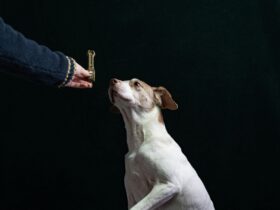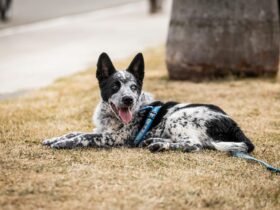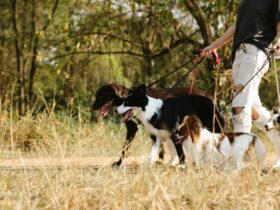Teaching a puppy to walk on a leash is an essential skill that can enhance both your and your puppy’s enjoyment of walks and ensure their safety. Leash training might seem straightforward, but it requires patience, consistency, and the right techniques. This guide will walk you through the process, providing detailed steps, tips, and common pitfalls to avoid.
1. Choose the Right Equipment
Before you start leash training, it’s crucial to select the right equipment:
- Leash: Opt for a 4 to 6-foot leash. Avoid retractable leashes for initial training as they can be less controllable.
- Collar or Harness: Choose a collar or harness that fits comfortably. A harness is often preferred for puppies as it distributes pressure more evenly and is gentler on their neck. Ensure the collar or harness is adjustable and snug but not too tight.
2. Introduce the Leash and Collar/Harness
Familiarize your puppy with the leash and collar/harness before you start walking:
- Let Your Puppy Explore: Allow your puppy to sniff and explore the collar or harness and leash. Place them near their food or toys to create a positive association.
- Positive Reinforcement: Reward your puppy with treats and praise when they show interest or accept the collar/harness and leash. This helps them associate these items with positive experiences.
3. Get Your Puppy Used to Wearing the Gear
Before starting leash training, let your puppy get comfortable wearing the collar or harness:
- Short Sessions: Put the collar or harness on your puppy for short periods while they are indoors. Gradually increase the duration as they become more comfortable.
- Playtime: Engage in play with the collar or harness on. This helps your puppy associate wearing it with fun activities and reduces any initial resistance.
4. Attach the Leash and Practice Indoor Walking
Start leash training indoors in a familiar and distraction-free environment:
- Attach the Leash: Clip the leash onto the collar or harness and let your puppy drag it around the house while supervised. This helps them get used to the feeling of having a leash attached.
- Encourage Movement: Gently encourage your puppy to follow you by walking around the room. Use treats or toys to guide them and keep their focus on you.
- Use Commands: Introduce simple commands such as “let’s go” or “walk” to signal the start of the walk. Consistency is key, so use the same command each time.
5. Practice Basic Walking Techniques
Once your puppy is comfortable with the leash indoors, move to outdoor training:
- Choose a Quiet Location: Begin leash training in a quiet, low-distraction area, such as your backyard or a quiet park. This makes it easier for your puppy to focus on you.
- Start Walking: Begin walking at a slow pace and encourage your puppy to follow. Use treats and praise to reward them for staying close and walking alongside you.
- Correct Pulling: If your puppy pulls on the leash, stop walking immediately. Wait for them to return to your side or loosen the leash before continuing. Use positive reinforcement to reward them when they walk beside you without pulling.
6. Teach Loose Leash Walking
The goal of leash training is to teach your puppy to walk on a loose leash:
- Use Treats for Guidance: Hold treats near your side to encourage your puppy to walk next to you. Reward them frequently for walking with a loose leash.
- Redirect Pulling: If your puppy starts to pull, gently redirect them back to your side. Use the command you’ve established (e.g., “heel”) and reward them when they return to walking beside you.
- Stay Calm: Maintain a calm demeanor. If you become frustrated, it can affect your puppy’s behavior. Patience and consistency are crucial for successful training.
7. Gradually Increase Distractions
As your puppy becomes more proficient with walking on a leash, gradually introduce more distractions:
- Vary Locations: Move to different environments, such as busier parks or streets, to help your puppy learn to focus despite the distractions.
- Introduce Other Dogs and People: Allow your puppy to interact with other dogs and people while maintaining control of the leash. Reward calm behavior and use treats to keep their attention on you.
8. Be Patient and Persistent
Leash training takes time, and each puppy learns at their own pace:
- Short, Frequent Sessions: Conduct short training sessions multiple times a day rather than one long session. This prevents fatigue and keeps your puppy engaged.
- Consistency is Key: Stick to a consistent routine and use the same commands and rewards. This helps your puppy understand what is expected and reinforces learning.
9. Address Common Challenges
During leash training, you may encounter common challenges. Here’s how to address them:
- Pulling: If your puppy pulls, stop walking and wait for them to return to your side. Avoid jerking the leash, as this can cause discomfort or fear. Redirect their attention with treats and continue walking once the leash is loose.
- Fear or Anxiety: If your puppy shows fear or anxiety, take a step back and retrain in a less stressful environment. Gradually reintroduce the leash and collar or harness and reward calm behavior.
- Distraction: If your puppy becomes easily distracted, use high-value treats or toys to maintain their focus. Practice in more controlled environments before gradually introducing more distractions.
10. Reinforce Training with Positive Experiences
Ensure that walking on a leash remains a positive experience for your puppy:
- End Walks on a Positive Note: Always end walks on a positive note by allowing your puppy to play or explore briefly. This helps create a positive association with leash time.
- Monitor Comfort: Regularly check the fit of the collar or harness to ensure it’s comfortable and not causing any irritation. Adjust as necessary to maintain your puppy’s comfort.
11. Incorporate Leash Training into Daily Routines
Leash training should be part of your puppy’s daily routine:
- Practice Regularly: Incorporate leash training into your daily walks and outings. Consistent practice helps reinforce good behavior and builds a strong walking routine.
- Use Leash Training for Other Activities: Utilize leash training for various activities, such as trips to the vet or visits to friends. This helps your puppy adapt to different environments and situations while on a leash.
12. Seek Professional Help if Needed
If you encounter persistent issues or need additional guidance:
- Consult a Professional: Consider seeking the help of a professional dog trainer or behaviorist. They can provide personalized advice and strategies tailored to your puppy’s specific needs.
- Join a Training Class: Enroll in a puppy training class where you can receive hands-on instruction and support from experienced trainers.
13. Enjoy the Process
Training your puppy to walk on a leash should be an enjoyable experience for both you and your puppy:
- Celebrate Progress: Celebrate small milestones and progress along the way. Recognize and reward improvements, no matter how minor.
- Bond with Your Puppy: Use leash training as an opportunity to strengthen the bond with your puppy. Positive interactions and shared experiences contribute to a strong, trusting relationship.
Conclusion
Teaching your puppy to walk on a leash is a fundamental skill that enhances their safety and your enjoyment of walks. By following these steps and tips, you’ll create a positive and effective leash training experience. Remember, patience, consistency, and positive reinforcement are essential components of successful training. Enjoy the journey and cherish the moments you share with your furry companion on your walks together!
Happy walking!











Leave a Reply